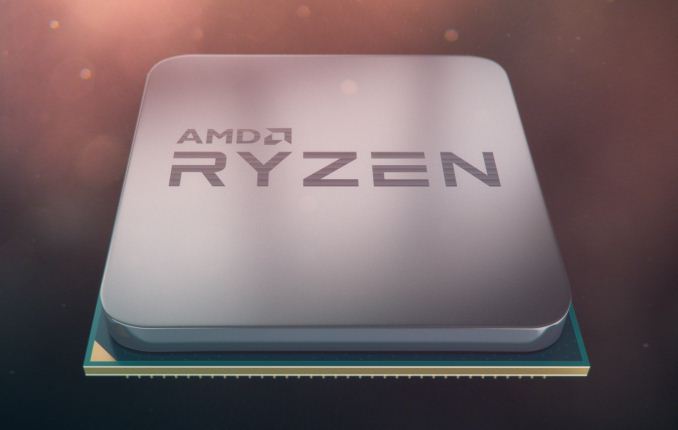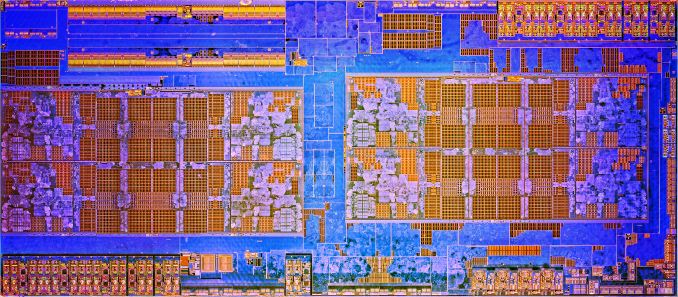AMD Launches Ryzen: 52% More IPC, Eight Cores for Under $330, Pre-order Today, On Sale March 2nd
by Ian Cutress on February 22, 2017 9:00 AM EST
The biggest x86 launch for AMD in five years is today: Ryzen is here. As always before a major launch, AMD gives a ‘Tech Day’ for relevant press and analysts, and through this event AMD’s CEO, Dr. Lisa Su lifted the lid on one of the most anticipated products in the semiconductor industry. AMD knows how to control the level of enthusiasm for its fans, and today is the end result, with processors going on pre-order from major retailers today at 1pm EST, ready for a general hard launch on March 2nd.
In a similar vein to launches of recent smartphones, AMD is doing a staggered announcement/launch with the products on their new microarchitecture. Where Samsung/Apple might give all the details for a product a few weeks before it’s available to buy, today on February 22nd marks the day where AMD is giving consumers information about Ryzen, and specifically the Ryzen 7 family of eight-core products. All the information today is from AMD, and AMD’s internal testing, and pre-orders also start from today for users ready to put down their money for a launch day part. Reviews of the CPUs, as well as when the CPUs will ship to customers, is on March 2nd. This also happens to be right in the middle of two annual shows, Game Developer Conference (GDC) and Mobile World Congress (MWC), making the time between receiving pre-launch samples and being able to provide independent verification of AMD’s performance claims relatively frantic. We’ll do our best!
The Ryzen Family
With a new processor launch, naming the parts and positioning them within the market is critical. So with Ryzen, the processor stack will be split into three based on performance and price: Ryzen 7 at the high end, Ryzen 5 in the middle, and Ryzen 3 for more price-conscious consumers. Both Ryzen 5 and Ryzen 3 are set to be launched later, and Ryzen 7 is the first portion of the family to be released.
Ryzen 7 will have three CPUs to start, all having eight cores and supporting simultaneous multi-threading:
- Ryzen 7 1800X: 8C/16T, 3.6 GHz base, 4.0 GHz turbo, 95W, $499
- Ryzen 7 1700X: 8C/16T, 3.4 GHz base, 3.8 GHz turbo, 95W, $399
- Ryzen 7 1700: 8C/16T, 3.0 GHz base, 3.7 GHz turbo, $329
Ryzen 7 1800X will be the high-end part, featuring a base clock of 3.6 GHz and a turbo of 4.0 GHz, within a TDP of 95W, and for $499. Next to this is Ryzen 7 1700X, launching at $399, with a base/turbo of 3.4/3.8 GHz. The final part for the launch is the Ryzen 7 1700, providing eight cores and sixteen threads for $329 at 3.0/3.7 GHz frequencies.
Processors will initially be available for pre-order from 185 retailers and OEMs worldwide, either as individual parts or pre-built systems.
What, not 40% IPC? 52% IPC??
Enthusiasts and analysts use the term IPC, or ‘Instructions Per Clock’, as a measure of how much the underlying microarchitecture improves from generation to generation. Two decades ago, a good design on a smaller node could net a healthy double-digit gain, whereas in recent years 5-10% gain has become the norm. When AMD initially announced that the new Zen microarchitecture they were developing was aiming for a 40% IPC gain, despite the low IPC they were starting from, users remained skeptical. AMD rehired Jim Keller to work alongside long-term AMD architect Mike Clark and produce a team with several goals in mind: high-performance x86, simultaneous multithreading, and a product to be relevant in the computing, PC, server and mobile space again. So despite this, 40% IPC always seemed a somewhat lofty goal, because Bulldozer was so underwhelming, and despite this low starting point. For the Ryzen launch today, AMD is stating that the final result of that goal is a 52% gain in IPC.
This is something we will need to test in due course!
The Ryzen Silicon, and the Future
AMD pointed out that the new 8-core silicon design runs 4.8 billion transistors and features 200m of wiring. Through previous announcements we’ve examined parts of the microarchitecture including cache sizes, threading, front-end/back-end design, and so on.
AMD Zen Microarchiture Part 2: Extracting Instruction-Level Parallelism
AMD Gives More Zen Details: Ryzen, 3.4 GHz+, NVMe, Neural Net Prediction, & 25 MHz Boost Steps
AMD’s CEO was keen to point out that this is a from-scratch design for AMD, using the knowledge gained from features developed for previous products but ultimately under the hood it looks like ‘a typical x86 high-performance core’, with AMD-specific features and tweaks. We were told that AMD’s roadmap extends into the multi-year range, so while the focus for 2017 will be on this family of products, back at HQ the next two generations are in various stages of development.
BENCHMARKS PLEASE
So despite the 82+ motherboards going to be available, 19 initial PC system builders moving into 200+ through the first half of 2017, the big question on everyone’s lips is how exactly does it perform?
Well, AMD gave us the following numbers:
AMD's benchmarks showed that the top Ryzen 7 1800X, compared to the 8-core Intel Core i7-6900K, both at out-of-the-box frequencies, gives an identical score on the single threaded test and a +9% in the multi-threaded test. AMD put this down to the way their multi-threading works over the Intel design. Also, the fact that the 1800X is half of the price of the i7-6900K.
In a similar vein, again with the Cinebench 15 multi-threaded test, the Ryzen 7 1700X scores over and above the Core i7-6800K (its price competition) and higher than the Core i7-6900K which costs 2.5 times as much.
We’ll tell you what our benchmarks say, with official retail processors. But you will have to wait until March 2nd. Sorry.





















386 Comments
View All Comments
deltaFx2 - Wednesday, February 22, 2017 - link
@ vladpetric: Fair enough. However, ARM has the same foundry exposure that AMD has. So, if your point is that Intel yields better than AMD, ARM won't change that.The other issue around ARM is the design point. Any CPU design has a sweet-spot: given an IPC and frequency, there's a point at which it is balanced in terms of perf and power. x86's sweetspot (intel and now AMD) is roughly at 3 GHz, which works for server, desktop and mainstream laptops. Intel and AMD have used economy of scale to push the same design in all these markets. However, in fanless laptop/tablet, the frequency has to be dropped to 1.5GHz, where the deeper pipeline starts to hurt. ARM designs' sweetspot is lower frequencies and much lower TDPs, resulting in short and/or less wide pipelines. These CPUs, designed for phones and scale up to tablets are sub-optimal for laptops, servers, or desktops, so they don't have the economy of scale. They have to design a from-scratch CPU to take Intel on head-on that they cannot sell in mobile, thus losing the cost advantage that intel/AMD have. Unless, of course, ARM becomes a real alternative for a mainstream laptop. The software isn't there yet for this to happen. It could, though, and if it does, my money is on Apple.
StevoLincolnite - Thursday, February 23, 2017 - link
Bullshit. ARM A15, A57 for instance has a 19 stage pipeline, A72 has a 16 stage pipeline and A73 has a 15+ stage pipeline.Sandy Bridge, 16 with fetch/retire, 14 without and that has remained consistence even today with Kaby Lake.
Of course, some instructions will not require the full use of the pipeline on both architectures.
deltaFx2 - Thursday, February 23, 2017 - link
@StevoLincolnite: I thought I was clear: "resulting in short and/or less wide pipelines". You can do one or the other to save power. A15 is in-order, A72/73 are 3-wide decode. Haswell/Skylake are 6-wide machines out of the uopCache. As is Apple, so that's a good comparison point. Apple's minimum mispredict penalty (aka front-end pipeline depth) is 9 cycles now. Haswell's minimum mispredict penalty on an uopcache miss I$ hit is ~20 cycles, and I think 16 on a uopcache hit. Apple clocks its parts at 2.3GHz tops, IIRC, in ipad pro.Also remember that it's not just about pipe stages, but physical design methodology. There are many tricks that you can play to hit high frequency that come at a significant power cost. I'll leave you with one datapoint: AMD, which knows how to do high-frequency design, put out an ARM server part, A1100 that used A57 cores as-is, hookedup with custom un-core. Top frequency? 2.0 GHz.
Meteor2 - Thursday, February 23, 2017 - link
Few will switch to ARM (or Power) for servers as the x86 software ecosystem is far broader and completely mature. It's far more expensive to switch software than hardware.jayfang - Thursday, February 23, 2017 - link
Sure, remember also: It's about the money.Apple's A10 Fusion can already pretty much replace Intel's expensive-for-their-die-size Core m line. That will hurt, especially when general ARM SoC catches up.
But the big growth and profit margin area is currently in server chips. The big cloud providers have no choice at the moment and are being milked. AMD can really make an impact there, for the reasons that @deltaFx2 puts so well.
bcronce - Friday, February 24, 2017 - link
Intel actually had a higher performance more efficient mobile CPU than ARM. The CPU is not everything. Turned out the platform as a whole, like the chipset, consumed way too much power for Intel.Arm has had the inverse issue. They can't compete with Intel's CPU performance without becoming horribly inefficient. Arm is still pretty much limit to embedded or many small core CPUs, which is a very niche market.
FullmetalTitan - Thursday, February 23, 2017 - link
As someone in the semicon industry who works with many former Intel employees, I can tell you they achieve their goals with a very heavy work demand of their engineers. One of the worst companies for work-life balance in the industry, profit above all.Yields make good news, but employee turnaround can break the bank.
mtroute - Friday, February 24, 2017 - link
as someone that works at Intel, I disagree...mdw9604 - Thursday, February 23, 2017 - link
Isn't AMD fabless now? So shouldn't manufactoring issue be a thing of the past, theoretically?tuxRoller - Wednesday, February 22, 2017 - link
I won't argue about their use of the ad hom, but 3-5 is right.David Kanter says the exact same thing, over and over.